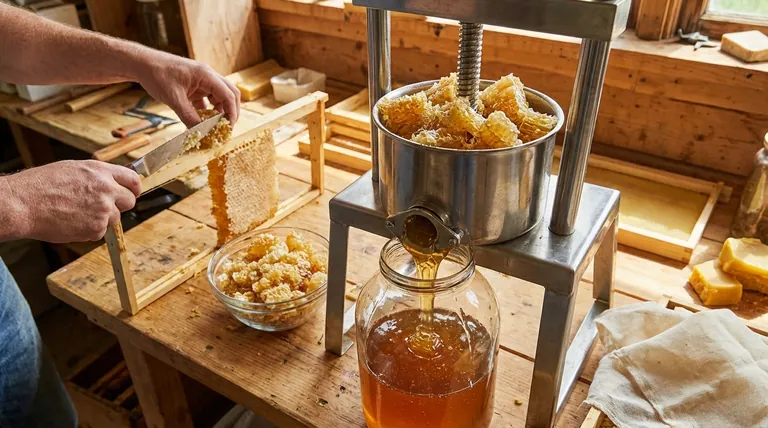This honey press is designed for crush-and-strain extraction, making it compatible with comb from top bar hives, long hives, and comb cut from Langstroth frames. You do not place the entire frame into the press; instead, you load the press with honeycomb that has been cut away from its frame and crushed.
The key takeaway is that this device is a comb press, not a frame extractor. Its compatibility is determined by your extraction method (crushing the comb) rather than the specific dimensions of your beehive frames.

The Core Principle: Crush-and-Strain Extraction
To understand which frames are compatible, you must first understand how this press works. It does not operate like a centrifugal extractor that spins frames to sling honey out.
What 'Crush-and-Strain' Means
This method involves physically removing the honeycomb from its frame or top bar. The comb is then crushed to break open the wax cells, and this mixture of honey and broken wax is placed into the press.
The press uses mechanical force to squeeze the crushed comb, forcing liquid honey out through a filter or screen while retaining the solid wax inside the basket.
Why This Changes the Idea of "Compatibility"
Because the comb is separated from its support structure before processing, the press itself never interacts with a full, intact beehive frame.
Therefore, the question is not "Which frame fits in the press?" but rather, "From which hive type can I easily get comb to crush?"
Deconstructing Compatible Hive Types
This press is ideal for any beekeeping style where the comb is harvested destructively.
Top Bar Hives
This is the most natural fit. In a top bar hive, the comb is attached only to a single wooden bar. Harvesting involves cutting the entire comb off this bar. This separated comb is exactly what a crush-and-strain press is designed for.
Langstroth Hives (With a Critical Caveat)
You do not put a standard Langstroth frame in this press. Instead, you must use a knife to cut the honeycomb out of the four-sided frame.
This method works best with foundationless Langstroth frames, where the comb is pure beeswax. If you use frames with plastic foundation, you must carefully cut the comb away from the foundation sheet before crushing.
Long Hives and Other Styles
"Long beehive frames" typically refers to hives that are managed horizontally, like a Langstroth hive turned on its side. The same principle applies: if you can cut the comb out of the frame, you can use this press.
Understanding the Trade-offs
Using a crush-and-strain press involves a clear choice between efficiency and resources. It is a simple, effective method, but it comes with consequences for your bees.
Advantage: Maximum Honey and Wax Yield
This method ensures you get every possible drop of honey out of the comb. It is also the only way to simultaneously harvest both your honey and your beeswax in a single process.
Disadvantage: Destructive Harvest
The primary drawback is that the honeycomb is completely destroyed. Your bees must expend significant time, energy, and nectar resources (consuming about 8 pounds of honey to produce 1 pound of wax) to rebuild all that comb from scratch.
Disadvantage: Labor and Filtering
The process is more hands-on than using a spinner. Cutting and crushing comb is a sticky job, and the resulting honey will contain many fine wax particles, often requiring more thorough filtering or settling time.
How to Apply This to Your Beekeeping Goal
Choosing an extraction method depends entirely on your beekeeping philosophy and equipment.
- If your primary focus is preserving comb for reuse (common in Langstroth beekeeping): This press is not your best choice for a primary extractor; a centrifugal spinner that keeps comb intact is far more efficient for the bees.
- If you are a top bar beekeeper: This press is a perfect, purpose-built tool that aligns directly with your hive management and harvest style.
- If your primary focus is processing wax cappings and broken comb: This press is an excellent secondary tool for any beekeeper, allowing you to reclaim honey that is otherwise difficult to extract.
By understanding that this is a tool for a specific process, not a specific frame, you can make the right choice for your apiary.
Summary Table:
| Hive Type | Compatible? | Key Consideration |
|---|---|---|
| Top Bar Hives | Yes | Natural fit; comb is cut directly from the bar. |
| Langstroth Hives | Yes* | Comb must be cut out of the frame; best with foundationless frames. |
| Long Hives | Yes | Same principle applies if comb can be cut from the frame. |
| *The press is compatible with the comb, not the full frame. |
Ready to choose the right extraction equipment for your apiary?
HONESTBEE supplies commercial apiaries and beekeeping equipment distributors with the durable, wholesale-focused supplies needed for any harvest method, from crush-and-strain presses to centrifugal extractors. Our expertise ensures you get the right tools to maximize your honey and wax yield efficiently.
Contact our wholesale experts today to discuss the best equipment for your operation's specific needs.
Visual Guide

Related Products
- Wooden Bee Hive Frames for Beekeeping and Wholesale
- Stainless Steel Honey Press Wax Press with Tank
- Honey Wax Separating Wax Press with Metal Screw Wax Separator Machine
- Stainless Steel Manual Honey Press with Guard for Pressing Honey and Wax
- 10L Stainless Steel Honey Wax Press Extractor for Wax Cappings
People Also Ask
- When should bee frames be thrown away? A Beekeeper's Guide to Hive Health & Biosecurity
- What parts of bee equipment should not be painted? Protect Your Hive's Interior for Bee Health
- When should I throw away my bee frames? A Guide to Proactive Hive Health
- What is the recommended number of frames for a beginner beekeeper? The Essential Rule for a Healthy Hive
- What are the primary uses of different Langstroth frame sizes? Optimize Your Hive for Health & Honey



















